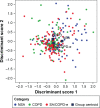Mixed Th2 and non-Th2 inflammatory pattern in the asthma-COPD overlap: a network approach
- PMID: 29483774
- PMCID: PMC5813946
- DOI: 10.2147/COPD.S153694
Mixed Th2 and non-Th2 inflammatory pattern in the asthma-COPD overlap: a network approach
Abstract
Introduction: The asthma-chronic obstructive pulmonary disease (COPD) overlap (ACO) is a clinical condition that combines features of those two diseases, and that is difficult to define due to the lack of understanding of the underlying mechanisms. Determining systemic mediators may help clarify the nature of inflammation in patients with ACO.
Objectives: We aimed at investigating the role and interaction of common markers of systemic inflammation (IL-6, IL-8, and tumor necrosis factor-α), Th2-related markers (periostin, IL-5, and IL-13), and IL-17 in asthma, COPD, and ACO.
Methods: This is a cross-sectional study of patients aged ≥40 years with a post-bronchodilator forced expiratory volume in the first second/forced vital capacity <0.70 recruited from outpatient clinics in tertiary hospitals with a clinical diagnosis of asthma, COPD, or ACO. ACO was defined by a history of smoking >10 pack-years in a patient with a previous diagnosis of asthma or by the presence of eosinophilia in a patient with a previous diagnosis of COPD. Clinical, functional, and inflammatory parameters were compared between categories using discriminant and network analysis.
Results: In total, 109 ACO, 89 COPD, and 94 asthma patients were included. Serum levels (median [interquartile range]) of IL-5 were higher in asthma patients than in COPD patients (2.09 [0.61-3.57] vs 1.11 [0.12-2.42] pg/mL, respectively; p=0.03), and IL-8 levels (median [interquartile range]) were higher in COPD patients than in asthma patients (9.45 [6.61-13.12] vs 7.03 [4.69-10.44] pg/mL, respectively; p<0.001). Their values in ACO were intermediate between those in asthma and in COPD. Principal component and network analysis showed a mixed inflammatory pattern in ACO in between asthma and COPD. IL-13 was the most connected node in the network, with different weights among the three conditions.
Conclusion: Asthma and COPD are two different inflammatory conditions that may overlap in some patients, leading to a mixed inflammatory pattern. IL-13 could be central to the regulation of inflammation in these conditions.
Keywords: COPD mechanisms; IL-13; asthma mechanisms; inflammatory cytokines; network analysis; overlap.
Conflict of interest statement
Disclosure Dr Pérez de Llano reports grants from SEPAR, during the conduct of the study, and grants and personal fees from Novartis, Chiesi, AstraZeneca, and Pfizer, outside the submitted work. Dr Cosío reports grants from SEPAR, during the conduct of the study, and personal fees from AstraZeneca, grants from Boehringer Ingelheim, grants and personal fees from Novartis, Chiesi, Rovi, Menarini, and Esteve, outside the submitted work. Dr Izquierdo reports and has received funds for advisory boards and lectures from Almirall, AstraZeneca, Bayer, GlaxoSmithKline, Novartis, Pfizer, Boehringer Ingelheim, Takeda, Chiesi, and Menarini. Dr Soler-Cataluña reports grants from SEPAR, during the conduct of the study and grants and personal fees from AstraZeneca, Boehringer Ingelheim, Novartis, Chiesi, Rovi, Menarini, and Esteve, outside the submitted work. Dr Miravitlles reports personal fees from Almirall, Boehringer Ingelheim, AstraZeneca, Chiesi, GlaxoSmithKline, Menarini, Teva, Grifols, and Novartis, outside the submitted work. The authors report no other conflicts of interest in this work.
Figures




References
-
- Barnes PJ. Immunology of asthma and chronic obstructive pulmonary disease. Nat Rev Immunol. 2008;8(3):183–192. - PubMed
-
- Orie NG, Slutter HJ, de Vries, Tammeling GJ. [Chronic nonspecific respiratory diseases] Ned Tijdschr Geneeskd. 1961;105:2136–2139. Dutch. - PubMed
-
- Vogelmeier CF, Criner GJ, Martinez FJ, et al. Global Strategy for the Diagnosis, Management, and Prevention of Chronic Obstructive Lung Disease 2017 Report: GOLD Executive Summary. Arch Bronconeumol. 2017;53(3):128–149. English, Spanish. - PubMed
-
- Cosio BG, Soriano JB, Lopez-Campos JL, et al. Defining the asthma-COPD overlap syndrome in a COPD cohort. Chest. 2016;149(1):45–52. - PubMed
-
- Cosio BG, Pérez de Llano L, Lopez Viña A, et al. Th-2 signature in chronic airway diseases: towards the extinction of asthma-COPD overlap syndrome? Eur Respir J. 2017;49(5):pii:1602397. - PubMed
Publication types
MeSH terms
Substances
LinkOut - more resources
Full Text Sources
Other Literature Sources
Medical
Miscellaneous

